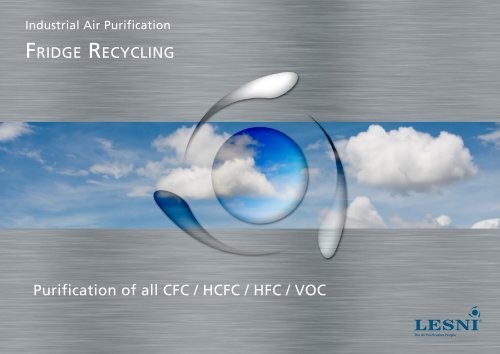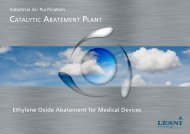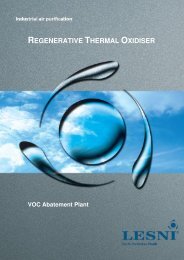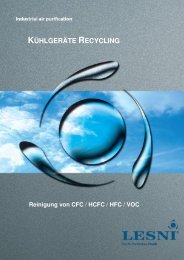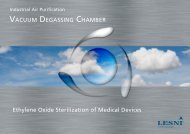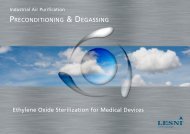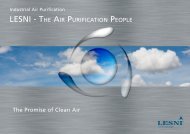CFC Abatement Plant - Fridge Recycling
Create successful ePaper yourself
Turn your PDF publications into a flip-book with our unique Google optimized e-Paper software.
Industrial Air Purification<br />
<strong>Fridge</strong> <strong>Recycling</strong><br />
Purification of all <strong>CFC</strong> / H<strong>CFC</strong> / HFC / VOC
Purification of Emissions from <strong>Fridge</strong><br />
<strong>Recycling</strong> Process<br />
The combined <strong>CFC</strong> / Pentane abatement plant provides a favourable<br />
and economical total air purification solution for onsite recovery<br />
and instantaneous destruction of all <strong>CFC</strong> and hydrocarbon gas<br />
emissions.<br />
Thus, treating all refrigerant gases as released into the contained<br />
process air extraction system, both from stage 1 (compressors), and<br />
from stage 2, with various other separating and shredding steps<br />
of the fridge defragmenting process. Hence, improving general<br />
operating environment, while eliminating the need to transfer<br />
refrigerant as hazardous waste for external destruction or disposal<br />
of liquid waste formed, and consequently operating costs.<br />
The mixture of refrigerants used as blowing agent released during<br />
the mechanical shredding and pulverisation of the fridge freezer<br />
units are completely extracted into confined air stream and purified<br />
to within European and international standards for air emission<br />
limits.
The extraction blowers delivering the exhaust fumes from the<br />
various stages of the mechanical pulverisation process maintain the<br />
airflow movement through the plant. This ensures that purification<br />
plant is continuously operating under negative pressure; thus<br />
ensure higher capture of all gas released and avoid fugitive leaks<br />
and emissions to the operating area.<br />
The whole abatement plant is supervised and operated from a<br />
dedicated control cabinet and PLC with touch operating panel,<br />
complete with all safety features for monitoring, trending and<br />
recording recovery of gas and performance.<br />
The LESNI plant includes 5 separate stages to control peaks and<br />
eliminate various pollutants:<br />
1. Dust Filter<br />
2. Adsorber<br />
3. Catalytic Abator<br />
4. Chemical Scrubber<br />
5. Neutralization of Waste Water
This well proven and developed solution has been successfully in operation for more<br />
than 15 years, where LESNI <strong>CFC</strong> Catalytic <strong>Abatement</strong> <strong>Plant</strong> is used to purify all exhaust air<br />
containing ODS (OZONE DEPLETING SUBSTANCES) such as Freon 11 & Freon 12, Pentane<br />
and Isobutene from recycling of fridge freezers.
Dust Filter<br />
Pulse jet filter and cartridge filters are used to collect any duct<br />
particles and prevent foam from accessing the other parts of the<br />
abatement plant.<br />
Adsorber<br />
Selected media is used to dampen gas peaks and remove heavy<br />
metals.<br />
Catalytic Abator<br />
For this process, the selective catalyst encourages thermal oxidation<br />
of refrigerants such as Freon 11 and 12 as well as hydrocarbons such<br />
as Pentane and Isobutane used in modern fridges at low operating<br />
temperature.<br />
While oxidation of VOC normally converts hydrocarbons into<br />
CO 2<br />
and H 2<br />
O in the gas phase; for <strong>CFC</strong>, HFC and H<strong>CFC</strong> refrigerant<br />
compounds, the selective catalyst used facilitate certain primary<br />
reactions on the chemical active surface to occur than direct<br />
oxidation in the gas phase, which partly is due to the high surface<br />
area and high number of internal pores of the catalyst.<br />
So in order to get the refrigerant oxidized, the refrigerant must<br />
first diffuse from the gas phase into the pores of the catalyst, on<br />
which they will adsorb, followed by a reaction with oxygen on<br />
a active site and finally desorption and diffusion back into the<br />
gas phase. This thermal cracking of the pollutants completes the<br />
conversion of fluoride and chloride ions selectively to HF and HCl gas.
The carrier exhaust air extracts from the shredding, separation and<br />
pulverisation stages are introduced through a recuperative heat<br />
F<br />
recovering system where the heat is supplied by the already cleaned<br />
air, before going into the catalytic chamber. Heater is used for<br />
preheating the process air to achieve the set controlled temperature<br />
for the purification process above.<br />
CI<br />
C<br />
CI<br />
CI<br />
The LESNI catalytic plant system for decomposing <strong>CFC</strong> and H<strong>CFC</strong><br />
from the fridge recycling process was specifically developed so that<br />
a very high degree of safety and purification is achieved.<br />
Once the inorganic gases <strong>CFC</strong> (Freon 11, 12 etc.) and other H<strong>CFC</strong><br />
CI<br />
have been selectively converted in the catalytic abator, according to<br />
the chemical reactions below, the acid gases generated are treated<br />
in the next step of the LESNI purification process.<br />
F<br />
C<br />
CI<br />
F<br />
Example for Freon 11<br />
<strong>CFC</strong>l 3<br />
+ 2 H 2<br />
O => 3 HCl + HF + CO 2<br />
Example for Freon 12<br />
CF 2<br />
Cl 2<br />
+ 2 H 2<br />
O => 2 HCl + 2 HF + CO 2<br />
Example for Pentane<br />
2 C 5<br />
H 10<br />
+ 15 O 2<br />
=> 10 CO 2<br />
+ 10 H 2<br />
O<br />
H H H H<br />
C<br />
C C H<br />
H C<br />
H H H H
Chemical Scrubber<br />
The chemical scrubber downstream of the catalytic abator placed<br />
to neutralise the acid exhaust generated before discharging to<br />
atmosphere.<br />
The scrubber will treat the inorganic gases that formed in the<br />
previous step such as HCl and HF. The gases are initially cooled<br />
in a quenching tower and then absorbed and neutralised in the<br />
absorption column. The scrubber liquid will be kept alkaline and<br />
the gases together with the NaOH form soluble salt products.<br />
When the concentration of salt reaches a certain level, the controller<br />
will desalt the scrubber tank and refresh the liquid by adding water<br />
and caustic soda automatically.<br />
Neutralisation of Waste Water<br />
The waste water/salt mix generated from previous step is then<br />
neutralized in the final step before permitting discharge of the<br />
final salt solution effluent to the drains or sewers depending on<br />
local authorities and demands.
Air purification by physical and<br />
chemical scrubbers<br />
Activated carbon plants for VOC purification,<br />
odour removal and solvent recovery<br />
Air purification systems for removing mist, dust<br />
and particulate matter<br />
Safe and efficient catalytic and thermal oxidisers for VOC<br />
purification and solvent destruction<br />
LESNI has developed a variety of innovative solutions for specific<br />
pollutants and processes in operation worldwide<br />
LESNI A/S<br />
Kornmarken 7<br />
DK-7190 Billund<br />
Denmark<br />
Tel.: +45 7533 2500<br />
Fax: +45 7533 3006<br />
info@lesni.com<br />
www.lesni.com<br />
Sales Office<br />
Tel.: +44 121 439 3278<br />
sales@lesni.com


